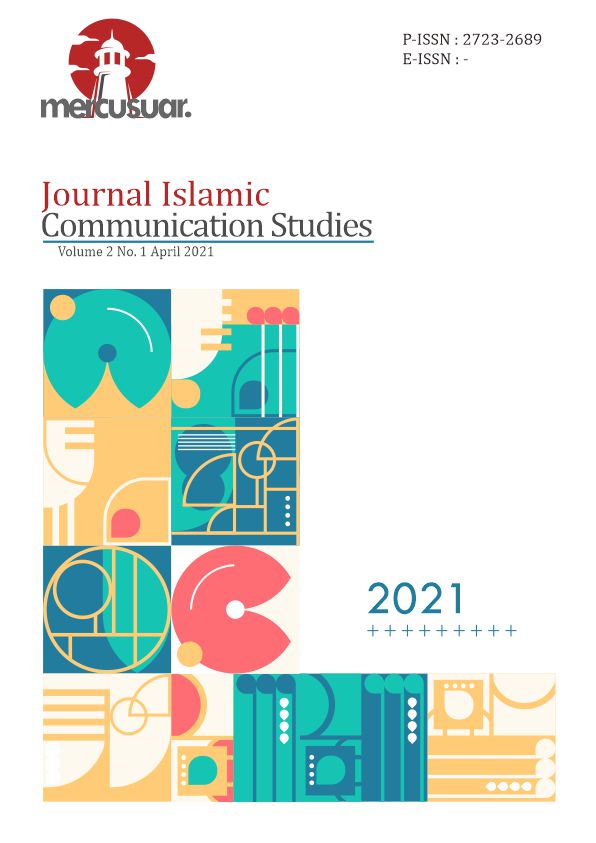Contribution of YouTube to Da'wah Activities during the Covid-19 Pandemic
Abstract
The main problem of this research is how YouTube has played a role in preaching activities during the Covid 19 pandemic. The subject matter is then divided into several sub-problems or research questions, namely: 1) What is the process of preaching through YouTube media during the Covid 19 Pandemic? 2) How did YouTube contribute to da'wah activities during the Covid 19 pandemic? This type of research is classified as a qualitative approach with a descriptive type of research that is field-oriented (field research). The data sources for this research are the dai who have a YouTube channel and the community of YouTube media users. Furthermore, the data collection methods used were observation, interviews, documentation, and reference tracking. Then, the data processing and analysis techniques were carried out through four stages: data collection, data reduction, data presentation, and drawing conclusions. The results of this study indicate that there are stages or steps taken by the preachers when preaching during the Covid 19 pandemic through YouTube media, including: 1) having an official channel account, 2) determining an interesting theme, 3) having supporting equipment or tools, 4) natural editing, 5) sharing content via social media, and teamwork for editing. In addition, YouTube media contributes to the community using YouTube by: 1) disseminating information that reaches a wider community, 2) expanding community insight, 3) providing a changing effect on society, 4) focusing attention, 5) fostering an atmosphere of entertainment, and 6) creating an atmosphere of community building. The implications of this research are: 1) YouTube channels should carry out a da'wah process that attracts the attention of dakwah viewers on YouTube, and 2) preachers who have a YouTube channel should have a da'wah theme syllabus so that the lectures on the YouTube channel are structured.
Downloads
References
Bahtar, Paradigma Dakwah Islam, Cet, I;
Palu: Yayasan Masyarakat Indonesia
Baru, 2009.
Bambang Prasetyo dan Lina Miftahul
Jannah, Metode Penelitian Kualitatif,
Jakarta: PT Rajagrafindo Persada,
Denis McQuail, Teori Komunikasi Massa
Suatu Pengantar, Jakarta: Erlangga,
Anonim, AL-Qur’an dan Terjemahnya
Bandung: CV. Jmanatul Ali Art, 2005.
Anonim. Kamus Besar Bahasa Indonesia
Edisi II. Cet.IV; Jakarta: Balai Pustaka,
Anonim, Kamus Besar Bahasa Indonesia,
Jakarta: Balai Pustaka, 2003.
Dilla, Sumadi. Komunikasi Pembangunan
Pendekatan Terpadu, Bandung:
Simbiosa Rakatama Media, 2007.
Enjang AS, 2009, Dasar-Dasar Ilmu Dakwah
(Bandung: Remaja Rosdakarya, 2009.
Ilaihi, Wahyu. Komunikasi Dakwah,
Bandung: Remaja Rosdakarya, 2010.
Kindarto, Asdani. Belajar Sendiri youtube
(Menjadi Mahir Tanpa Guru) Jakarta:
PT Elexmedia Komputindo, 2008.
Krispendoff, Klaus. Analisis Isi Pengantar
dan Teori Metodologi, Jakarta:
Rajawali Press, 1993.
Kriyantono, Rachmat. Teknik Praktik Riset
Komunikasi, Jakarta: Kencana
Prenada Media Group, 2006..
lvinaro dan Lukiati, Komunikasi Massa
Revisi, Bandung: Simbiosa Rekatama
Media, 2007.
M. Romli, Asep Syamsul. Jurnalistik Online,
Bandung: Penerbit Nuansa Cendekia,
Moleong, Lexy J. Metodologi Penelitian
Kualitatif, Bandung: Remaja
Rosdakarya, 2009.
Muhtadi, Asep Saeful. Metode Peneitian
Komunikasi Peneitian Kuantitatif:
Teori dan Aplikasi, Bandung: Pustaka
Setia, 2015.
Mulkhan, Abdul Munir. Paradigma
Intelektual Muslim, Cet. II;
Yogyakarta: Sipress, 1994.
Nasrullah, Rusli. Media Sosial Perspektif
Komunikasi, Budaya, dan
Sosioteknologi, Bandung: Simbiosa
Rekatam Media, 2016.


